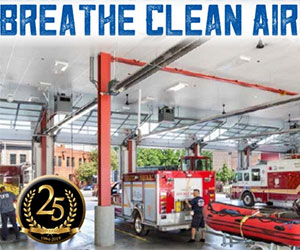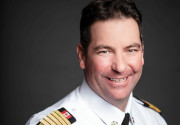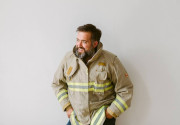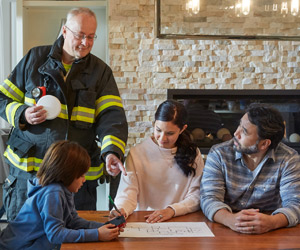| |
| |
 |
 |
| |
 |
|
@{mv_date_MMM d, yyyy}@ |
|
| |
Upgrades to communications systems in British Columbia’s wildfire zones are needed to save lives and properties, says a report released Wednesday. The Thompson Rivers University report, which examined B.C.’s communications practices during the devastating wildfire seasons of 2017 and 2018, calls for improvements to better inform people about risks before, during and following wildfires.
» Read more...
Ian Duncan of the Saanich Fire Department in British Columbia cycled for 24 hours straight to raise awareness for ALS, because his dad was diagnosed earlier this year with the neurological disease. Goldstream News Gazette reports.
» Read more...
CIBC Run for the Cure returns October 3, and North Bay’s police, fire, and paramedic services in Ontario are all taking part to raise funds for the cause. BayToday reports.
» Read more...
In B.C., Langley Township firefighters say they need more funding to safely staff the fire trucks heading out to fires and other emergencies. Aldergrove Star reports.
» Read more...
|
| |
 |
 |
| |
|
| |

Protect first responders with the AIRVAC 911® Engine Exhaust Removal System. No hoses and hands free, this automatic system protects 100% of the apparatus bay area by constantly monitoring and automatically removing diesel exhaust and particulate matter from your station. At the heart of our four-stage filtration system is a MERV 16 rated filter that has the ability to remove particles 0.3-1.0 microns in size at an efficiency of greater than 95%.
There are no building modifications, vehicle attachments, ducting or external exhaust fans. Plus, the system doesn’t interfere with daily operations or response time. Address hot zones by removing off-gassing of turnout gear, hoses and parked vehicles. Remove “engine backwash” every time a vehicle leaves and returns.
AIRVAC 911 ® meets NFPA requirements, is half the cost of hose systems and the only maintenance is periodic filter changes.
Control the spread of contaminants.
>> Request your free proposal. |
| |
|
| |
 Mental health has changed from taboo to a top priority in fire departments. In Ontario, the Barrie Fire and Emergency Service (BFES) operates a mental health initiative that aims to create a healthy and supportive environment to benefit firefighter mental health. The program has been ongoing for a year and a half. By Maz Atta
» Read more...
Mental health has changed from taboo to a top priority in fire departments. In Ontario, the Barrie Fire and Emergency Service (BFES) operates a mental health initiative that aims to create a healthy and supportive environment to benefit firefighter mental health. The program has been ongoing for a year and a half. By Maz Atta
» Read more... |
| |
 Our last stop on why the philosophy of Stoicism and cognitive behavioural therapy (CBT) are good approaches for resilience lies with our thoughts. This is purposeful — often thoughts are the first place people wish to look when trying to address mental health and other problems in their personal life. For me to hear, “if only I could stop thinking about…” is almost a guarantee. This is likely because of the ease for which we can access them. Yet, as we have discussed in Part 1 and Part 2 of this series, the influences of our emotions and behaviours are an equal force in determining how we think, feel, and act in situations. By Nick Halmasy
» Read more...
Our last stop on why the philosophy of Stoicism and cognitive behavioural therapy (CBT) are good approaches for resilience lies with our thoughts. This is purposeful — often thoughts are the first place people wish to look when trying to address mental health and other problems in their personal life. For me to hear, “if only I could stop thinking about…” is almost a guarantee. This is likely because of the ease for which we can access them. Yet, as we have discussed in Part 1 and Part 2 of this series, the influences of our emotions and behaviours are an equal force in determining how we think, feel, and act in situations. By Nick Halmasy
» Read more... |
| |
|
| |

As temperatures drop and families continue to spend more time at home, it’s critical that smoke and CO alarms are installed and everyone is aware of home safety best practices.
To help your team engage residents, check out First Alert’s “Safety Corner” blog on www.firstalert.ca for home safety statistics, how-to tips and other educational content that can be leveraged in CRR communications. New to the First Alert website is a laws and legislation map that provides provincial updates on alarm requirements. This can also serve as a resource to direct residents and help educate your community about the importance of smoke, fire and CO safety.
>> Learn more |
| |
|
| |
Luck, I have heard it said many times, is when preparation meets your opportunity.
How many times have you responded to a call and after a successful fire fighting operation have someone comment about how lucky the crew was to save the building or stop the fire when you did. These people would go on to further comment on what the negative outcomes may have been had your crew not been lucky to respond to the emergency when you did and take actions the way we do. In making complimentary conversation, they attempt to lift our spirits and acknowledge good work in their own way. They say we were lucky. By Vince Mackenzie
» Learn more
|
|
This year marks the 20th anniversary of Trainer’s Corner and I am filled with gratitude for this incredible opportunity afforded to me by Fire Fighting in Canada. Jim Hailey the editor at that time, was very supportive of the idea for a feature column addressing the needs of the volunteer training officer. The opening paragraph for my first column read: “This column will hopefully be viewed as a great resource for the volunteer fire service training officer. The intention here is to provide some tried and tested training drills that are “do-able” with our limited budgets. This first one is simple to set up and yet challenging enough to keep your members’ interest.” By Ed Brouwer
» Learn more
| | |
| FIRE FIGHTING IN CANADA: THE PODCAST |
|
|
| |
|
Laura King, the NFPA’s public education representative for Canada, joins host Fire Chief Tom DeSorcy for a conversation about this year’s Fire Prevention Week. Running Oct. 3-9, this year’s Fire Prevention Week is called Learn the Sounds of Fire Safety and focuses on teaching the public about what the sounds made by smoke and carbon monoxide alarms means. King and DeSorcy talk about the importance of public education, NFPA’s calls-to-action and goals, as well as how the organization is working towards making Fire Prevention Week more accessible through virtual events and translations.
» Listen now |
| |
|
| |
October 3, 2021
Location: Queen’s Park, Toronto
» Learn more
|
| |
| |








